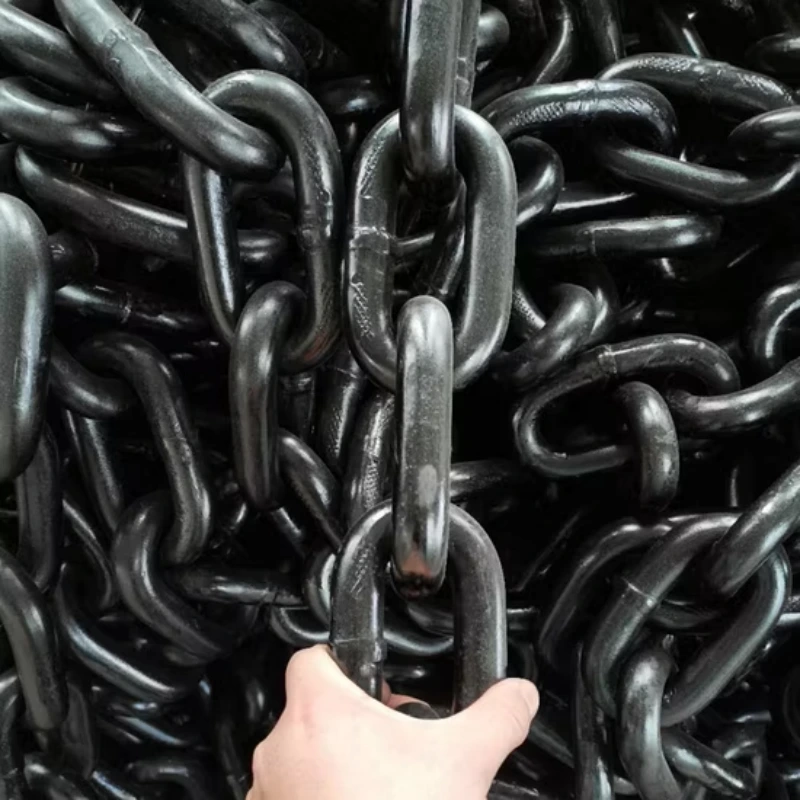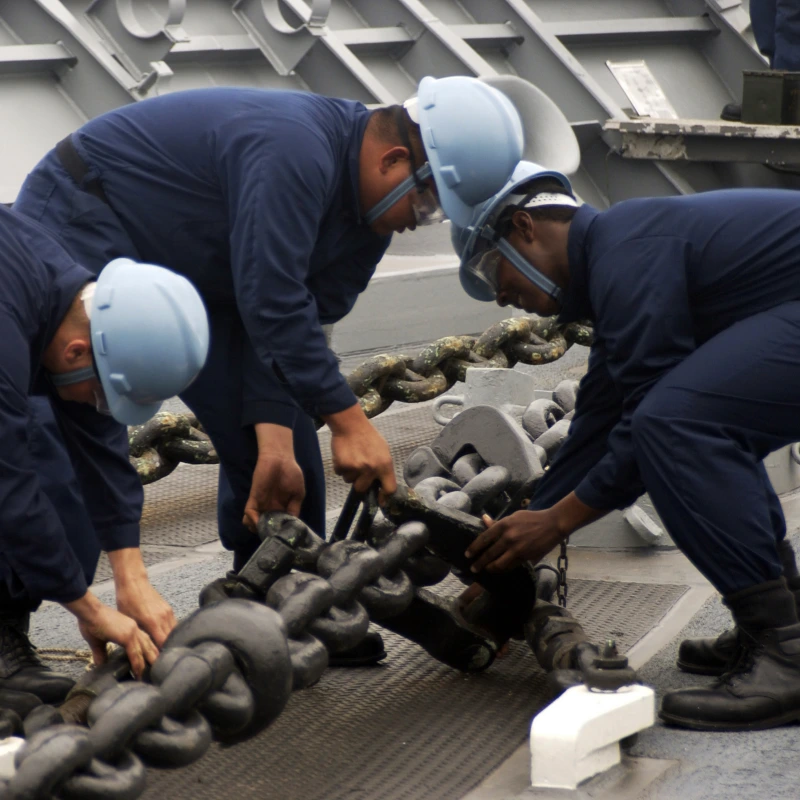If you want the best balance of durability, corrosion resistance, and cost, galvanized anchor chains often suit most marine users. However, when comparing stainless vs galvanized anchor chains, it’s important to note that stainless steel chains deliver superior strength and resist corrosion better, but you pay more for that quality.
Galvanized chains last longer and cost less, though they perform weaker in saltwater environments. Powerful Machinery offers both types, ensuring you get certified, reliable anchor chains for your vessel.
Feature | Stainless Steel | Galvanized Chain |
|---|---|---|
Durability | Superior | Long-lasting |
Corrosion Resistance | Excellent | Less in saltwater |
Cost | Expensive | Least expensive |
Key Takeaways
Stainless steel anchor chains offer superior corrosion resistance and longevity, making them ideal for saltwater environments.
Galvanized anchor chains are more affordable and provide good strength, but they require more maintenance and have a shorter lifespan.
Choose the right chain based on your vessel type, budget, and the marine environment you operate in for optimal performance.
Regular inspections and maintenance are crucial for both chain types to ensure safety and reliability during use.
Powerful Machinery provides certified anchor chains in both stainless and galvanized options, ensuring quality and compliance with marine standards.
Anchor Chain Types
When you choose an anchor chain, you need to understand the differences between stainless steel and galvanized steel options. Each type offers unique benefits for marine use, and Powerful Machinery provides both to meet your needs.
Stainless Steel Chains
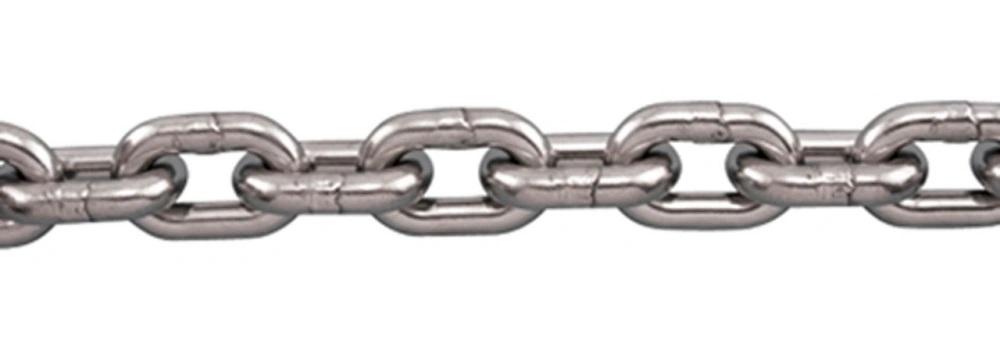
Stainless steel anchor chains deliver excellent resistance to corrosion, especially in saltwater. You often see these chains on yachts and high-end vessels where appearance and long-term durability matter. Stainless steel chains come in various grades, with AISI 316 being a popular choice for marine environments.
These chains resist marine degradation better than most alternatives, but they can stain over time and cost more than galvanized options.
Stainless steel chains offer:
Superior corrosion resistance in harsh marine conditions
Long service life with minimal maintenance
A polished finish that maintains its look
Higher initial investment
Powerful Machinery manufactures stainless steel anchor chains in both studless and stud link designs. You can select the right chain for your vessel, whether you need flexibility or maximum strength.
Galvanized Steel Chains
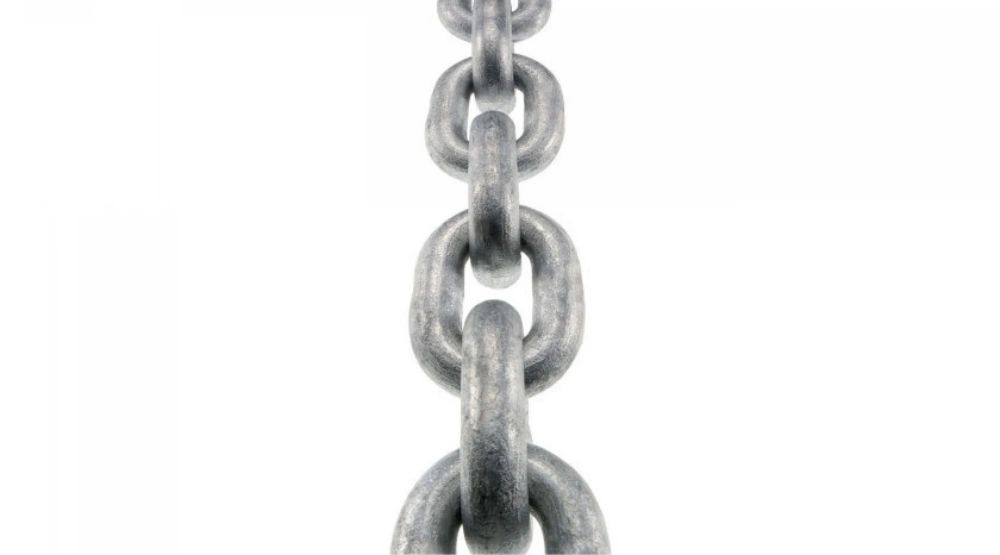
Galvanized anchor chains use a hot-dip process to coat steel with zinc. This finish forms a deep bond with the steel, protecting it from rust. Galvanized chains are common on commercial and recreational boats because they balance cost and durability.
Over time, the zinc layer will wear, and the chain may eventually rust, but you get reliable performance at a lower price.
Galvanized chains provide:
Strong protection against corrosion for most marine settings
Affordable pricing for budget-conscious users
Compatibility with a wide range of anchors
Chain Grade | Material Type | Minimum Breaking Strength (MPa) | Characteristics |
|---|---|---|---|
G30 | Carbon Steel | 300 | Similar to BBB chain |
G40 | Carbon Steel | 400 | Standard for recreational use |
G43 | Carbon Steel | 430 | Higher strength option |
G70 | Heat-Treated Steel | 700 | High-strength applications |
Tip: When comparing stainless vs galvanized anchor chain, consider your vessel type, budget, and the environment where you operate.
Studless and Stud Link Chains for Marine Applications
You can choose between studless and stud link anchor chains based on your needs:
Stud link chains offer maximum strength and durability. You should use them for large vessels and heavy-duty anchoring.
Studless chains are lighter and more flexible. They work well for smaller boats, yachts, and situations where easy handling and weight savings matter.
Studless chains adapt better to uneven seabeds and are easier to store on board.
The absence of studs in studless chains reduces the risk of snagging on debris, making them safer to use.
Powerful Machinery supplies both studless and stud link anchor chains, ensuring you find the right solution for any marine application.
Material & Build
Steel Grades
When you compare anchor chains, you need to understand the steel grades that define their strength and durability. Stainless steel chains use grades like G3, G4, and G6.
Galvanized chains typically use Grade 30, Grade 40, and Grade 70. Each grade offers different mechanical properties and price points. You can see how these grades stack up in the table below:
Steel Grade | Type | Break Load Comparison | Price Comparison |
|---|---|---|---|
G3 | Stainless | Lower than G4 | Approximately 3 times G40 |
G4 | Stainless | Higher than G3 | Higher than G40 |
G6 | Stainless | Supreme quality | Highest among grades |
Grade 30 | Galvanized | Lower than Grade 40 | N/A |
Grade 40 | Galvanized | Standard | N/A |
Grade 70 | Galvanized | Higher than Grade 40 | N/A |
You should choose a grade based on your vessel’s needs and the environment. Higher grades mean greater strength and longer service life, but they also increase cost. When you weigh stainless vs galvanized anchor chain, consider how the steel grade affects both performance and budget.
Manufacturing Process
The manufacturing process for anchor chains plays a critical role in their reliability and safety. Powerful Machinery follows strict procedures to ensure every chain meets international standards. Here are the key steps you should know:
Raw material receiving and inspection for quality and specifications.
Batch or lot samples testing for quality assurance.
Cutting materials to precise lengths.
Forging links through heating and hammering to boost strength.
Flash trimming to remove excess material and create clean edges.
Machining or forging cross bars for added stability.
Final assembly of all components for reliability.
Heat treatment and inspection for defects.
Galvanizing with zinc for corrosion protection.
Welding quality and material choice also impact the chain’s load-bearing capacity and resistance to corrosion. You get a chain that performs well in demanding marine conditions when these steps are followed with precision.
Tip: Always check for certified manufacturing processes when selecting your anchor chain. This ensures you receive a product that meets safety and durability standards.
Corrosion Resistance
Saltwater Performance
You face tough conditions when you anchor your vessel in saltwater. Saltwater accelerates corrosion, so your choice of anchor chain matters. Stainless steel chains resist rust and pitting much better than galvanized chains.
The chromium in stainless steel forms a protective layer that shields the metal from saltwater damage. You see this advantage most clearly on yachts and commercial vessels that operate in harsh marine environments.
Galvanized chains rely on a zinc coating to protect the steel. This coating works well at first, but it wears down over time. Once the zinc layer fades, the steel underneath starts to corrode.
You may notice rust spots after just one season if you use galvanized chains in saltwater. Regular rinsing and maintenance help, but the protection does not last as long as stainless steel.
Note: If you operate in saltwater year-round, stainless steel anchor chains offer the best long-term resistance to corrosion.
Longevity
When you compare stainless vs galvanized anchor chain, you need to consider how long each type lasts. Stainless steel chains stand out for their exceptional durability. You can expect them to serve reliably for many years, even with frequent exposure to saltwater. Galvanized chains, on the other hand, show signs of corrosion much sooner.
Stainless steel anchor chains have a significantly longer lifespan in marine environments.
Galvanized chains can show corrosion after just one season due to the wear of the zinc coating.
Stainless steel chains are recognized for their exceptional durability and longevity.
You get more value over time with stainless steel, especially if you want to minimize replacement costs and downtime. Galvanized chains work well for short-term or seasonal use, but they require more frequent inspection and replacement.
Chain Type | Average Lifespan in Saltwater | Maintenance Needs |
|---|---|---|
Stainless Steel | Many years | Minimal |
Galvanized | One season to a few years | Frequent inspection |
Tip: Choose stainless steel if you want the longest service life and the least maintenance in marine environments.
Strength & Durability
Breaking Strength
When you compare anchor chains, breaking strength is a critical factor. You want a chain that can handle the forces your vessel faces at anchor. Stainless steel chains often come in higher grades than galvanized chains, which means they can offer greater strength for the same size.
Stainless steel chains are available in G4, G6, and G6+ grades.
Galvanized chains are typically found in Grade 30, Grade 40, and Grade 70.
Higher grades mean higher breaking strength and better performance under heavy loads.
If you operate a larger vessel or anchor in challenging conditions, you should consider a higher-grade chain. Stainless steel options give you more choices at the top end. When you weigh stainless vs galvanized anchor chain, always match the grade to your vessel’s needs.
Tip: Always check the manufacturer’s specifications for breaking strength before making your final choice.
Wear Over Time
Durability is not just about strength on day one. You need a chain that stands up to years of use. Stainless steel and galvanized chains wear differently over time, especially in harsh marine environments.
Chain Type | Lifespan |
|---|---|
Stainless Steel | 15-20 years |
Galvanized Steel | 5-10 years |
The zinc coating on galvanized chains wears away, especially in saltwater.
In mild conditions, galvanized chains can last for decades, but harsh environments speed up the wear.
Stainless steel chains resist wear and corrosion much longer, making them ideal for long-term use.
“The beginning of degradation in galvanized chain is seen as rust and wear from friction… I attribute this to the friction from the shearing of the boat about the fixed anchor.”
When you choose between stainless vs galvanized anchor chain, think about how often you want to replace your chain and how much maintenance you want to perform. Stainless steel chains offer a longer service life and less frequent replacement.
Maintenance
Cleaning
Proper cleaning extends the life of your anchor chain and keeps your vessel safe. Stainless steel chains require less maintenance because they resist corrosion. You only need to rinse them with fresh water after each use, especially if you operate in saltwater. Visual inspection is usually enough to spot any issues.
Poor manufacturing can still cause early corrosion, so always choose certified chains.
Galvanized chains need more attention. The zinc coating protects the steel, but it can wear off over time. You should rinse your galvanized chain with fresh water after every trip.
Regular cleaning removes salt and debris that speed up corrosion. If you notice the zinc layer thinning or rust spots forming, consider re-galvanizing the chain to restore protection.
Here’s a quick comparison of maintenance routines:
Type of Anchor Chain | Corrosion Resistance | Maintenance Routine |
|---|---|---|
Stainless Steel | Highly resistant to corrosion, minimal maintenance | Minimal cleaning, visual inspection, less likely to rust |
Galvanized | Good resistance, zinc coating can wear off | Regular cleaning, re-galvanizing as needed |
Tip: Always store your anchor chain in a dry, ventilated area to prevent moisture buildup and rust.
Common Issues
You can avoid most anchor chain problems with regular inspections and proper care. Before each outing, check your anchor and chain for signs of wear or damage.
During the boating season, inspect your chain at least once a month. At the start and end of each season, perform a thorough inspection. After rough weather or heavy use, check the chain immediately.
Common maintenance steps include:
Rinse the chain with fresh water after every use.
Applying marine-grade lubricants to moving parts.
Using protective coatings to boost corrosion resistance.
Replace any parts that show significant wear, deformation, or rust.
You should replace your anchor chain every 5–7 years as a preventive measure, even if it looks fine. This routine keeps your anchoring system reliable and your vessel secure.
Cost Comparison
Initial Price
When you compare anchor chains, price often becomes your first concern. Stainless steel anchor chains cost more upfront than galvanized steel chains. You pay a premium for the superior corrosion resistance and polished finish.
Galvanized chains offer a budget-friendly solution for most boat owners. The zinc coating protects the steel, but the manufacturing process keeps costs low.
Chain Type | Typical Initial Price (per meter) | Appearance | Common Use Cases |
|---|---|---|---|
Stainless Steel | $$$ | Polished, shiny | Yachts, premium vessels |
Galvanized Steel | $ | Matte, gray | Workboats, fishing |
You might choose galvanized steel if you want to save money at the start. Stainless steel appeals to you if you value long-term durability and aesthetics.
Tip: Consider your vessel type and anchoring environment before making a decision based on price alone.
Long-Term Value
The initial price does not tell the whole story. You need to think about how much you will spend over the life of your anchor chain. Stainless steel chains last up to 15 years with minimal maintenance. Galvanized chains typically last 5-10 years, but harsh conditions can reduce their lifespan to 3-5 years.
Galvanized chains require re-galvanizing every 2-3 years. This adds to your long-term costs.
Stainless steel chains do not need frequent maintenance. You avoid the hassle and expense of regular re-coating.
The higher initial cost of stainless steel may become cost-effective after five years. You spend less on maintenance and replacement.
If you operate in saltwater or use your vessel year-round, stainless steel chains offer better value. You replace them less often and spend less time on upkeep. Galvanized chains suit you if you use your boat seasonally or in freshwater. You accept more frequent maintenance and replacement for a lower upfront cost.
Note: Investing in a higher-quality chain can save you money and effort over time. Consider both initial price and long-term value when choosing your anchor chain.
Powerful Machinery Anchor Chains
Studless Anchor Chain Features
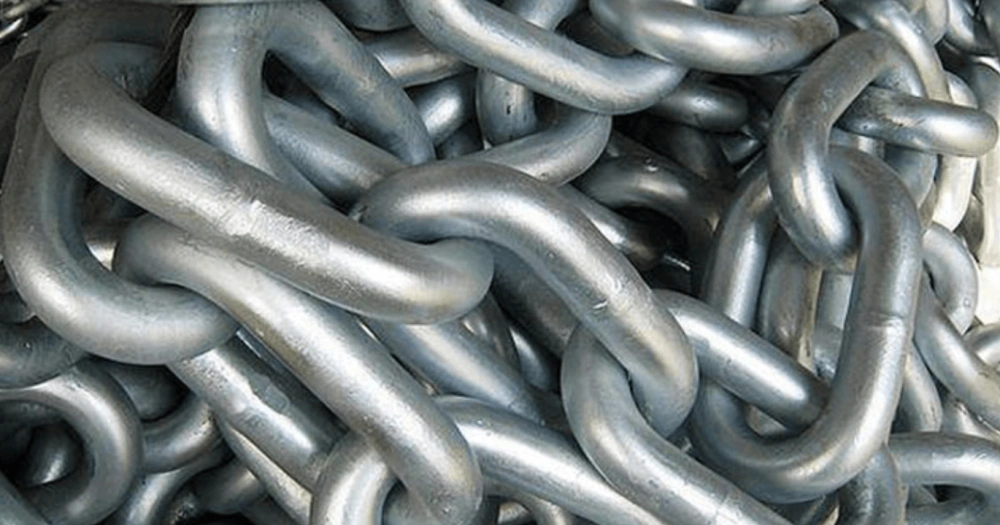
You want anchor chains that deliver maximum strength and reliability in tough marine environments. Powerful Machinery’s studless anchor chains meet industry benchmarks for performance and safety. The design eliminates weak points by removing internal studs, which reduces the risk of chain failure.
You benefit from oval or circular links that move smoothly and minimize entanglement. Continuous welded links create a secure connection, so you can trust your chain during critical anchoring operations.
Designed for maximum strength and durability in harsh marine conditions
Absence of studs eliminates weak points, reducing failure risk
Smooth link shape allows for easy movement and less entanglement
Welded links ensure a strong, secure connection
Smooth surface resists corrosion and wear
You can customize these chains to fit your vessel’s requirements. Powerful Machinery offers options in material, length, and finish, so you get a chain that matches your anchoring system.
International certifications guarantee safety and reliability. You receive chains that comply with ISO standards and are certified by RINA and BV, giving you confidence in every deployment.
Certification | Impact on Reliability |
|---|---|
ISO9001 | Ensures quality management and compliance with safety regulations |
API | Validates performance and safety standards in the industry |
DNV | Enhances safety, quality, and regulatory compliance |
Note: Certified studless anchor chains from Powerful Machinery provide peace of mind for both recreational and commercial marine users.
Stud Link Chain Advantages
You need anchor chains that withstand heavy loads and maintain stability in demanding marine applications. Powerful Machinery’s stud link chains set the industry standard for ship anchor chains.
The interlocking stud connections ensure secure anchoring, preventing accidental detachment under high tension. High-strength steel construction delivers the durability required for offshore and shipping operations.
Prevents knotting and twisting, ensuring stability during use
Maintains link shape under extreme tension, protecting load capacity
Facilitates smooth passage through guide wheels, preventing jamming
Increases weight and stability, helping the anchor grip the seabed
Interlocking studs provide secure connections for high-load anchoring.
High tensile strength withstands heavy loads, essential for large vessels.
Standardized sizes and grades ensure compliance with safety and reliability standards.
You can select from a range of sizes and grades to match your vessel’s needs. Powerful Machinery’s stud link chains are certified to international standards, including ISO9001 and API, ensuring you receive products that meet strict safety and performance requirements.
Tip: Choose Powerful Machinery anchor chains for proven reliability, certified quality, and tailored solutions for any marine environment.
Stainless vs Galvanized Anchor Chain: Performance Review
Pros & Cons
When you compare stainless vs galvanized anchor chain, you need to weigh the strengths and weaknesses of each option. Both types serve important roles in marine applications, but they excel in different areas.
Stainless Steel Anchor Chain:
Delivers outstanding resistance to rust and corrosion, even in harsh saltwater.
Maintains a polished, attractive appearance over time.
Requires minimal maintenance and cleans easily with specialized agents.
Lasts significantly longer than galvanized chains, with many users reporting service lives well beyond a decade.
Costs much more than galvanized options, often two to three times higher.
It may offer lower rupture strength compared to galvanized steel of the same size.
Not ideal for low-oxygen environments, such as when buried in mud.
Galvanized Steel Anchor Chain:
Provides strong protection against corrosion through a zinc coating.
Offers excellent value and affordability for most boaters.
Delivers higher rupture strength in some sizes, such as a 10 mm galvanized chain rated at 5800 kg.
Remains the most common choice for marine anchor chains due to its balance of strength and cost.
The zinc layer will eventually wear off, leading to rust stains, especially in salty or harsh environments.
Requires more frequent inspection and maintenance to prevent corrosion.
The grippier surface may cause more friction in chain lockers compared to the smoother stainless finish.
Note: Many marine industry experts recommend galvanized steel for general marine use, while stainless steel stands out for longevity and aesthetics.
Feature | Stainless Steel Chain | Galvanized Steel Chain |
|---|---|---|
Corrosion Resistance | Superior | Good, but zinc wears off |
Appearance | Polished, shiny | Matte may show rust stains |
Maintenance | Minimal, easy to clean | Needs regular inspection |
Cost | High | Affordable |
Strength (same size) | Slightly lower | Higher rupture load |
Lifespan | 10+ years | 3-5 years (typical) |
Best Use Cases
You should choose your anchor chain based on your vessel type, environment, and budget. Here are the best scenarios for each chain type:
Stainless Steel Anchor Chain:
Ideal for yachts, premium vessels, and situations where appearance matters.
Best for saltwater environments where you want minimal maintenance and maximum longevity.
Suitable if you operate in areas with high salinity and need a chain that resists marine degradation.
Works well when you want a smooth finish for easy handling and storage.
Not recommended for anchor rodes that will be buried in mud or low-oxygen conditions.
Galvanized Steel Anchor Chain:
Perfect for commercial boats, workboats, and recreational vessels that need strength and value.
Preferred in most marine environments, especially where cost is a concern.
Performs well in both freshwater and saltwater, though you must monitor for rust as the zinc wears off.
Offers higher rupture strength for the same size, making it a strong choice for heavy-duty anchoring.
Suitable for users who accept more frequent maintenance in exchange for lower upfront costs.
Tip: If you mix stainless and galvanized components, you risk accelerating corrosion. Always match your chain and fittings to avoid this issue.
When you consider stainless vs galvanized anchor chain, Powerful Machinery provides certified options in both categories. You can select studless or stud link designs, customize the length and finish, and trust that each chain meets international safety standards.
Your choice should reflect your vessel’s needs, your maintenance preferences, and the marine environment you face.
Recommendations
Coastal Cruising
When you cruise along the coast, you need an anchor chain that balances strength, compatibility, and ease of use. In North America, G4 (High Test) chains have become the standard for coastal cruising.
You benefit from their high strength-to-weight ratio, which allows you to use a smaller chain without sacrificing performance. BBB chains, once popular, now see less use because they are heavier and offer lower strength. Proof coil chains do not work with most windlasses, making them unsuitable for many modern boats.
Chain Type | Material | Strength-to-Weight Ratio | Windlass Compatibility |
|---|---|---|---|
G30 – Proof Coil | Low Carbon Steel | Standard | ❌ Not compatible |
BBB Anchor/Windlass Chain | Low Carbon Steel | Normal | ✅ Compatible |
G4, G40, G43 – High Test | High Carbon Steel | Twice that of BBB | ✅ Compatible |
G70 – Transport | High Carbon Steel | 25% stronger than G4 | ⚠️ Limited compatibility |
Tip: Choose G4 chain for coastal cruising if you want reliable strength and seamless windlass operation.
You should select a chain that matches your vessel’s anchor system. Powerful Machinery offers certified G4 and BBB chains, ensuring you get the right fit for your cruising needs.
Offshore Use
Offshore environments demand anchor chains that withstand harsh conditions and extended exposure to saltwater. You must consider corrosion resistance, strength, and maintenance requirements.
Stainless steel chains excel in offshore use because they resist rust and require minimal upkeep. Galvanized chains offer strong performance and cost savings, but they need more frequent maintenance.
Feature | Galvanized Chain | Stainless Steel Chain |
|---|---|---|
Cost | More cost-effective | Higher price |
Corrosion Resistance | Will eventually rust | Superior corrosion resistance |
Appearance | Less visually appealing | More aesthetically pleasing |
Maintenance | Needs regular attention | Easier to maintain |
Strength | Varies by grade | Available in higher grades |
Surface Finish | Grippier surface | Smoother finish |
If you operate in saltwater for long periods, you should choose stainless steel for its longevity and ease of care. Galvanized chains work well for shorter offshore trips or when you prioritize budget.
Powerful Machinery provides both options, including stud link and studless designs, so you can select the chain that matches your offshore requirements.
Note: For offshore use, prioritize corrosion resistance and strength. Stainless steel chains deliver the best performance in demanding marine environments.
Budget Choices
If you want the most value for your investment, galvanized steel anchor chains offer excellent strength and durability at a lower price. The zinc coating protects the steel from saltwater corrosion, making these chains a practical choice for budget-conscious users.
Stainless steel chains provide superior rust resistance and a polished look, but you pay two to three times more for these benefits.
Galvanized steel chains deliver reliable performance and cost savings.
Stainless steel chains suit you if you value appearance and minimal maintenance.
Powerful Machinery’s galvanized chains meet international standards, giving you peace of mind without overspending.
💡 Tip: Select galvanized steel anchor chains for the best balance of cost and performance. You get dependable strength and corrosion protection at a price that fits your budget.
You can trust Powerful Machinery to supply certified anchor chains that match your needs, whether you cruise the coast, venture offshore, or seek the most cost-effective solution.
Conclusion
You see clear differences when comparing stainless vs galvanized anchor chain. Stainless steel chains excel in corrosion resistance and longevity, while galvanized chains offer strong value and reliable performance.
Your choice depends on your vessel, environment, and budget. Powerful Machinery’s certified anchor chains stand out for several reasons:
High strength keeps your vessel secure.
Durability ensures reliable use in harsh marine conditions.
Compliance with marine standards supports safety and reliability.
Robust holding power protects your crew and vessel.
Long-lasting performance saves you time and money.
Choose Powerful Machinery for anchor chains that deliver safety and peace of mind.
FAQ
What is the main difference between stainless and galvanized anchor chains?
Stainless steel chains resist corrosion better and last longer in saltwater. Galvanized chains cost less and offer good strength, but the zinc coating wears off over time. You should choose based on your environment and budget.
How do I choose the right anchor chain size for my vessel?
You need to match the chain size to your vessel’s weight and anchor system. Always check your boat manufacturer’s recommendations. Powerful Machinery provides detailed specifications to help you select the correct diameter and grade.
Can I mix stainless steel and galvanized components in my anchor system?
Avoid mixing stainless and galvanized parts. This combination can cause galvanic corrosion, which damages both materials. Always use matching metals for your chain, shackles, and anchor to ensure maximum durability.
How often should I inspect or replace my anchor chain?
Inspect your anchor chain monthly during the boating season. Look for signs of rust, wear, or deformation. Replace galvanized chains every 5–7 years. Stainless steel chains last longer but still require regular checks for safety.
Are the Powerful Machinery anchor chains certified for marine use?
Yes. Powerful Machinery anchor chains meet international standards like ISO9001 and RINA. You receive certified products designed for marine environments, ensuring safety and reliability for your vessel.

